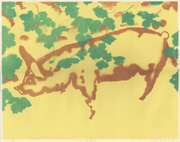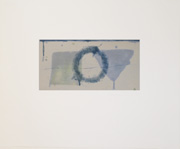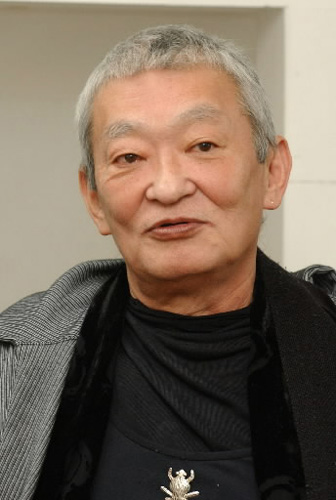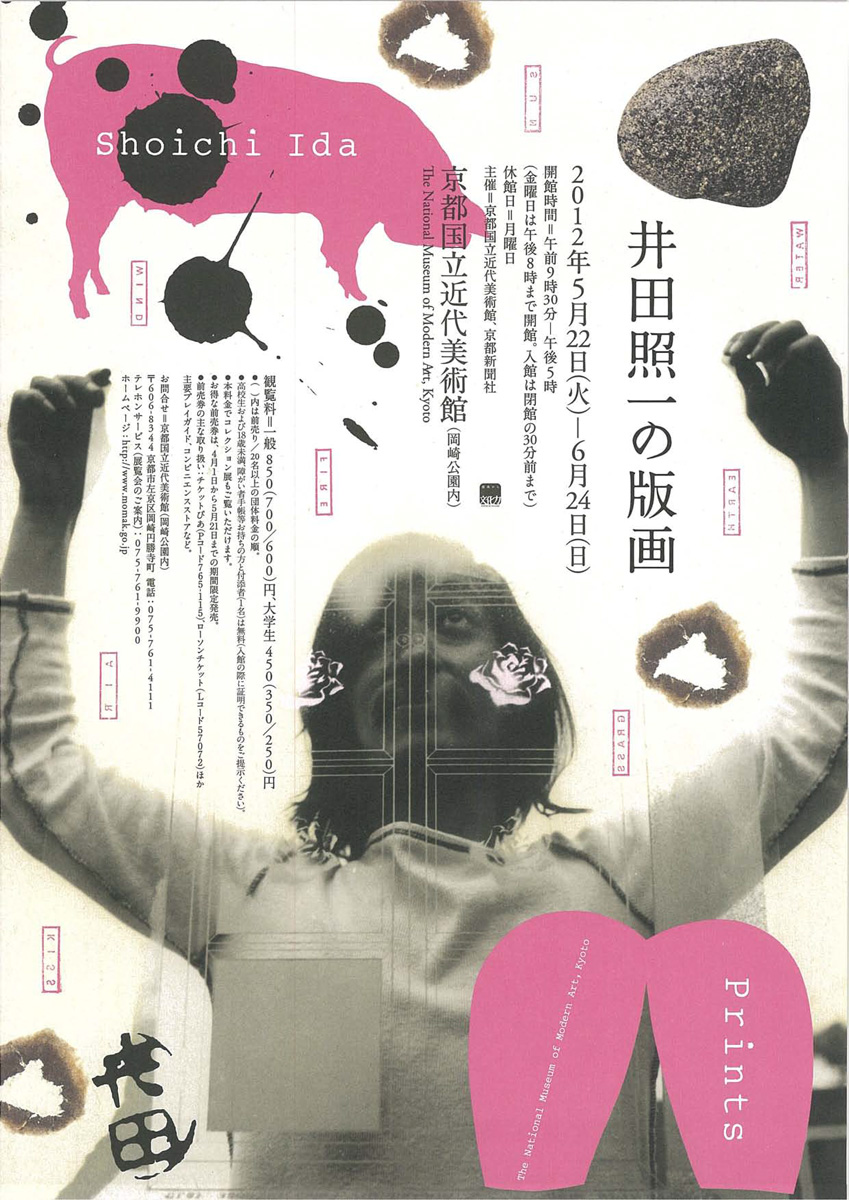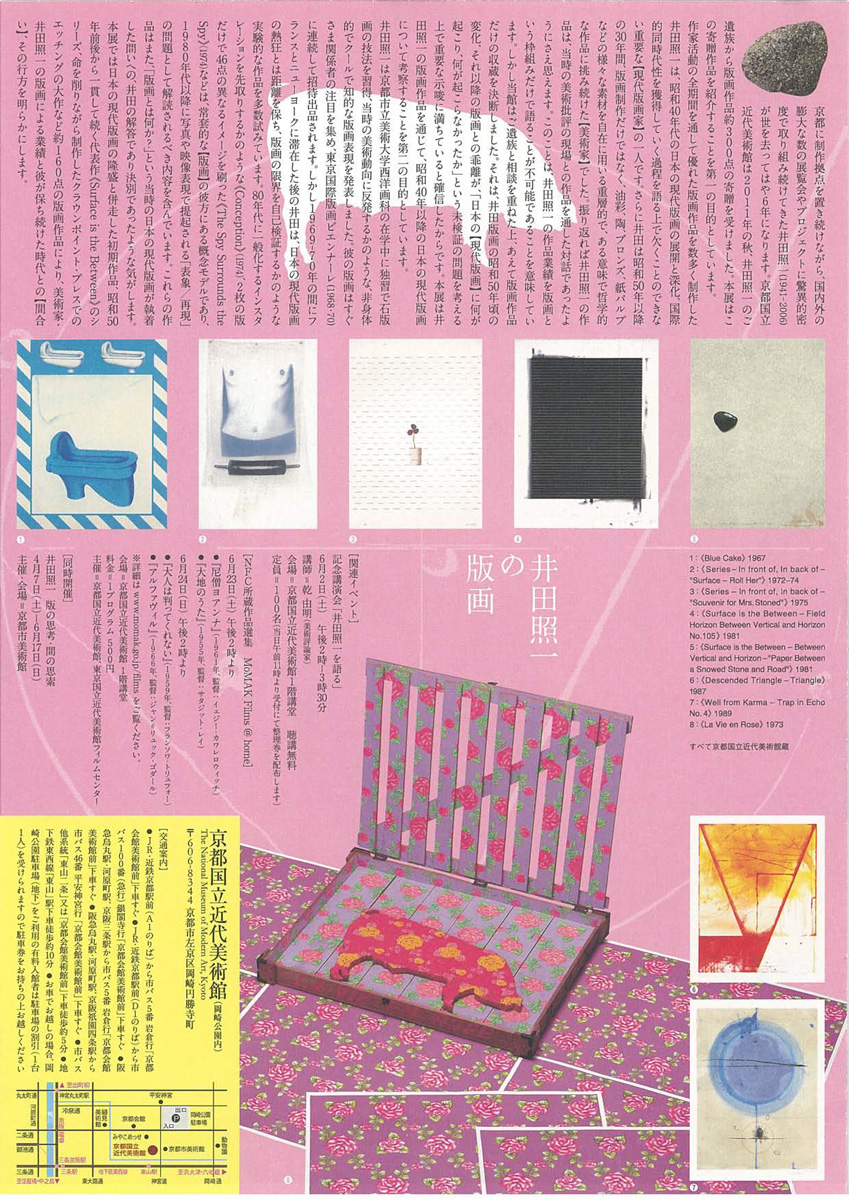IHL Cat. #2036
Measure and Pig, 1972
IHL Cat. #2037
IHL Cat. #1324 | 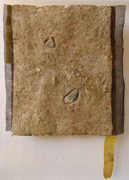 (mixed media collage) IHL Cat. #221 |
Biography
Ida Shoichi 井田照一 (1941-2006)
Sources: http://www.bellasartesgallery.com/ida_bio.html and as footnoted.
Shoichi Ida, who has lived, worked and exhibited internationally throughout his career, has chosen to remain in the traditional Japanese city of Kyoto where he was born in 1941. He earned a postgraduate degree from the Oil Painting Department of Kyoto Municipal University of Art in 1965. He received a grant in 1968 from the French government to live and work in Paris and also lived briefly in New York and in San Francisco.
Among his many awards are the Award For Excellence in International Cultural Exchange from the National Endowment for the Arts presented to him and Robert Rauschenberg in 1986 and the prestigious Suntory Prize in Japan awarded to him in 1989.
Best known for his paper works and prints, Ida has worked with a variety of media from painting, drawing, ceramics, metal, stone and cloth to environmental and installation art. Ida's art involves a melding of Eastern traditions with a truth to materials common to Western Minimalism. The link between the two is nature. Ida has for many years worked on a series titled Surface is the Between which he explained in an interview published in the Hara Museum Review Spring 1987.1
| The "Surface" can be the paper or canvas or whatever, it is the point of contact between me and the ideas I am working on or the other materials I am working with. Or, an easier way to understand this might be to say that while we are talking now, there is a space between us where communication takes place. That space is important to appreciate — but you can't really see it, it's just air. You can't see the wind either, but if you look at the branches of a tree moving you can see the force of the wind. Through my work I try to make invisible phenomena visible by showing the point of contact. |
Printmaking
Ida was perhaps best known as a paper artist and printmaker. He told Constance Lewallen of Crown Point Press in a 1989 interview1 that he was moved to begin making prints in the early 1960s when a stone left an impression on a piece of paper in his studio. In addition to a great deal of print work in Japan, he produced five portfolios of etchings with Crown Point Press between 1984 and 1992 and a woodcut in Crown Point’s Japan program in 1986.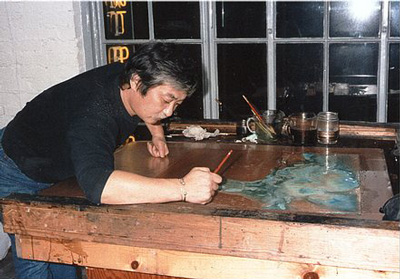
Shoichi Ida using spit bite at a downdraft table, San Francisco, 1987
Crown Point Press
In the same interview, in response to a Lewallen question regarding his preferences in print media, Ida responded:
| I don't have any preference. I will work with any medium, because each has its own character which I try to discover and bring out. For instance, etching is interesting because of the way acid bites into the plate, and because of the physicality of the process. The result of the work, the something "Between Vertical and Horizontal," is what emerges from the interaction of the forces involved. As an artist I create situations to discover my relationship to substances.2 |
1 View,Vol. VI, NO. 4, Fall 1989, p. 5, Point Publications "Interview by Constance Lewallen at Crown Point Press, San Francisco, California, June 1989"
2 Ibid. p. 7.
"The Surface is the Between"
| ‘The Surface is the Between…’ has always been a very interesting concept for me because I am always looking for… that which is between function and effect. I use this expression as a descriptive title for many of my works. It is my own concept of nature, all those natural events, states, and phenomena called ILLUSIONS.”1 – Ida |
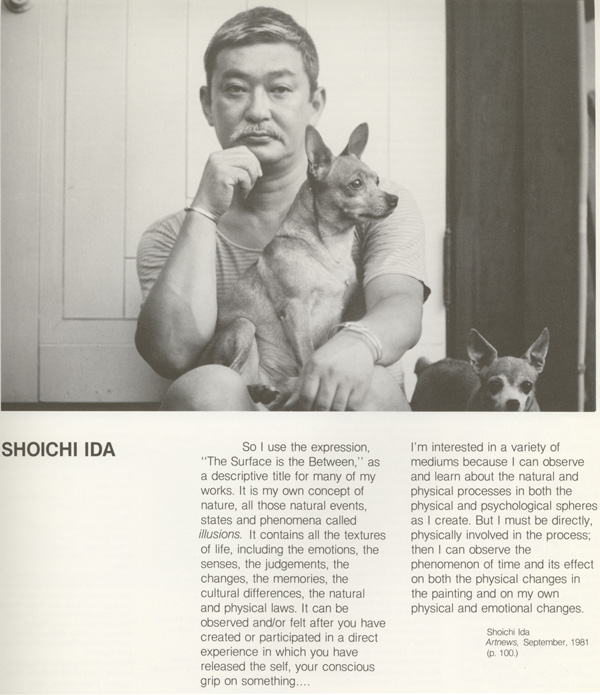
Comments by the Artist
Source: Crown Point Press website http://www.crownpoint.com/artists/ida/index.html“Art is not making a beautiful surface, or drawing a realistic apple. Art is getting to an essence, reaching the senses.”
Source: The Artist.org website http://the-artists.org/artist/Shoichi_Ida.html
"Art should not be an artist's monologue; it should be able to set up some form of communication. This is why it's sometimes necessary for me to become a nobody. By dropping my own identity I try to put myself in the same space as the communication process between the materials and whatever stands opposite them. This then makes it possible for the "entity" opposite the materials to be the viewer of my works."
according to what is the surface is the between
between light and shadow,
vertical and horizon.
gravity.
Recent Exhibitions
Shoichi IDA, Prints
http://www.momak.go.jp/English/exhibitionArchive/2012/391.html
The National Museum of Modern Art, KyotoSix years have passed since the death of the artist Shoichi Ida (1941–2006), who worked on countless exhibitions and projects on an international level, while remaining based in Kyoto. In the Fall of 2011, the National Museum of Modern Art, Kyoto received a gift of 261 prints and 1 oil painting from the Ida Shoichi Studio and the artist's family.
Shoichi Ida made a vast number of excellent prints throughout his artistic career. Needless to say, he is one of the most important printmakers in the story of the so-called "Golden Age of Contemporary Prints", or the development of Japanese contemporary prints and the process of their gradual attainment of an international contemporaneity over the course of the late sixties and early seventies. Furthermore, during the three decades that followed, Ida not only continued his printmaking but also worked very freely with a variety of materials, including works in oil on canvas, ceramics, bronze, and paper pulp, engaging in a multitiered and, in a sense, philosophical artistic practice and thus producing many works that resonated with the currents in art criticism in Japan at that time. In retrospect, it seems as though his entire oeuvre could be described as a critical dialogue with their contemporary discourse about art. This proves that it is impossible to discuss Ida's practice solely within the context of prints. In spite of this, following many discussions with the artist's family, we have decided to specifically limit our collection of Ida's works to his prints alone. The decision was based on the conviction that his works – particularly the transformation seen in his works especially around 1974–75 and their divergence from conventional prints thereafter – are full of hints in considering the unsolved mystery of what did and did not happen during the "Golden Age of Contemporary Prints" in Japan, or, in other words, the question of whether the issues related to the "Golden Age of Contemporary Prints" in Japan in the late sixties and early seventies are in fact limited to prints alone.
As a student in the Oil Painting course at the Kyoto Municipal University of Art (the present Kyoto City University of Arts), Ida taught himself the technique of lithography, and made brightly-colored, cool prints with little to no emphasis on the body that come across as a backlash against the trends in art of that time, in which individuality, the body, and pathos were lauded. His prints immediately came to the attention of the art world, and he was specifically invited to exhibit his works in two consecutive International Biennial Exhibitions of Prints in Tokyo (1968 and 1970). However, after spending time in Paris and New York in 1969–70, Ida maintained a subtle distance from the frenzy surrounding contemporary prints in Japan, and took part in the challenging practice of making experimental works that seem to be a sort of self-verification of the limits of prints as a mode of expression. Such works as Conception (1974), which went ahead of its time with its use of the technique of installation that later became popularized in the 1980s, and The Spy Surrounds the Spy (1974), in which Ida made fifty different prints using just two plates, can be described as "conceptual models of vision" that go far beyond the clichéd framework of "prints". These works are Ida's response to the self-referential question of the definition of prints – centered on arguments about the problem of originals and their copies (or multiplicity and signatures) – with which those involved in the creation and criticism of contemporary Japanese prints were obsessed. His response can also be understood as his break with contemporary printmaking. As the story that "'anti-art' and 'Gutai' were the main trends of Japanese art in the fifties and sixties, and 'Mono-ha' was that of the seventies" is now gradually becoming fixed, we hope that our studies of Shoichi Ida's prints will encourage the reconsideration of the excellent work of many artists in the late sixties and early seventies that lie outside of this sweeping generalization, and that it will contribute a supplementary footnote to the gaps (or the intermediate regions) within this nearly-established story.
Collections
(Partial list)Victoria and Albert Museum - London, England
National Museum of Modern Art - Kyoto
National Museum of Modern Art - Tokyo
Tokyo Metropolitan Art Museum - Tokyo
Museum of Modern Art - New York, NY
Los Angeles County Museum of Art
Ministry of Culture - Tokyo, Japan
Cincinnati Art Museum - Cincinnati, OH
Hokkaido Museum of Modern Art - Sapporo
Chateau de L’Hermitage - Belgium
Warsaw National Museum - Warsaw, Poland
Walker Art Center - Minneapolis, MN
National Museum of Modern Art - Ljubljana, Yugoslavia
The National Museum of Art - Osaka, Japan
Hara Museum of Contemporary Art - Tokyo, Japan
Museum of Contemporary Art - Seoul, Korea
British Museum - London, England
Ohara Museum - Kurashiki, Japan
Freer Gallery of Art - Washington, DC
Smithsonian Institution - Washington, DC
Wakayama Prefectural Museum of Art - Wakayama
Hyogo Prefectural Museum of Modern Art - Kobe, Japan
Suntory Museum of Art - Tokyo, Japan
San Francisco Fine Arts Museums - San Francisco, CA
Zimmerli Art Museum, Rutgers University - New Brunswick, NJ
Portland Art Museum - Portland, OR
Museum of Modern Art, San Francisco, CA
Museum of Modern Art, Chicago, IL
New York Public Library, NY
